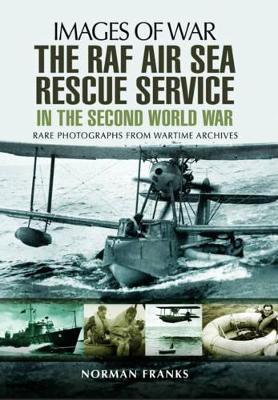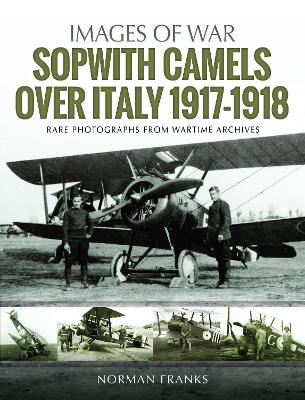Images of War
6 total works
When the Second World War began in 1939 it was thought that it would be fought along the same lines as the First World War, with the Allied air forces operating from both Britain and France. With the fall of Britain's Northern European Allies in May 1940, all that changed. From then onwards, RAF aircraft operating over enemy and enemy-held territory necessitated flights across both the North Sea and the English Channel. This meant that aircrew in difficulties would be forced to come down in both of these bodies of water. Therefore it was essential that some form of rescue service be made available to fish these airman from the water. But there were no aircraft in existence at that time that were designed for such a task: initially all that could be done was to use land 'planes to help locate anyone in the water, drop a dinghy to them, and then guide a boat to their position. Obviously a quicker and more reliable means of rescue was needed, and this came in the shape of the Supermarine Walrus, an amphibian aeroplane that could land on both sea and land.Several Flights of these aeroplanes were set up around the coast of Britain, concentrated mainly around the south and south-east of England.
The Air Sea Rescue airmen did a magnificent job from 1941-45, rescuing hundreds of downed RAF and USAAF aircrew. It took a special type of airman to undertake these rescues - and another kind of courage. As the war in North Africa developed, Walrus aircraft were needed in the Mediterranean, and later on either side of the Italian coast. Walrus squadrons operated just as successfully in this theatre as around Britain. Aircrew operating over any stretch of water could always count on the ASR boys coming to their aid. This is their story.
The Air Sea Rescue airmen did a magnificent job from 1941-45, rescuing hundreds of downed RAF and USAAF aircrew. It took a special type of airman to undertake these rescues - and another kind of courage. As the war in North Africa developed, Walrus aircraft were needed in the Mediterranean, and later on either side of the Italian coast. Walrus squadrons operated just as successfully in this theatre as around Britain. Aircrew operating over any stretch of water could always count on the ASR boys coming to their aid. This is their story.
Aviation historians will know that the Avro Lancaster bomber is the most famous aircraft to have fought with RAF Bomber Command during World War Two. They will know too that, of the 7,366 that were built, over 3,400 were lost on operations and a further 200 plus were destroyed and written-off in crashes. Operational sorties flown totalled more than 156,000, carrying over 600,000 tons of bombs to targets all over Europe. But this came at a terrible cost. With extensive losses on some night operations, occurring when bombers were pitted against a dedicated German night-fighter arm (as well as anti-aircraft fire) it is not surprising, or even incredible, that just 35 Lancasters managed to complete 100 or more sorties during the course of the war. A number of them actually achieved well over one hundred sorties, and a few were tragically lost after reaching this amazing figure. This book covers the history of these 35 incredible Lancasters, featuring many photographs of both aircraft and crew members drawn together in an effort to create a photographic record of these veterans.In addition, there is a section dedicated to many Lancasters that, whilst not achieving this almost magic total, either through eventual loss or the ending of the war, did achieve a large number of operations.
Pictures of these have been added so that their achievements, as well as the achievements of the crews who flew in them, can be viewed together.
Pictures of these have been added so that their achievements, as well as the achievements of the crews who flew in them, can be viewed together.
By the close of 1916, the air war over France was progressing amazingly. The Royal Flying Corps, the French Air Force and the opposing German Air Service, were all engaged in fierce aerial conflict and the Allied air forces were following a particularly successful if aggressive policy. They were taking the war to the Germans by constantly crossing the massive trench system that stretched from the North Sea to the Swiss border. With observation and bombing aircraft requiring constant protection from the German fighter Jastas, the fighter aces on both sides soon gained publicity and fame as a result of their daily engagements. This book explores the many ways in which fighter pilots developed tactics in order to outdo the opposition in the fight for allied victory. In so doing, they achieved high honours on account of their prowess in the skies. It also looks at the development of militarised flight during the course of these key years, revealing how each side constantly endeavoured to improve their aircraft and their gunnery.By early 1918 the Americans were also starting to take part in the war against Germany, and any number of US citizens were joining both the French Air Service as well as manning their own Aero Squadrons.
This publication covers the development of American air combat, whilst also recording the efforts of some of their ace pilots flying both British and French aircraft with precision and skill.
This publication covers the development of American air combat, whilst also recording the efforts of some of their ace pilots flying both British and French aircraft with precision and skill.
This book summarises the story of how RAF Coastal Command overcame the German U-boat danger during the Second World War and how the escalation of the U-boat war promoted the development of anti-submarine warfare, leading to victory over this menace in the Atlantic. At the start of the war, RAF Coastal Command had virtually no real chance of either finding or sinking Germany's submarines, but within a short period of time, new methods of detecting and delivering deadly ordnance with which to sink this underwater threat were dreamt up and implemented. It took the men of Coastal Command long hours patrolling over an often hostile sea, in all types of weather, but their diligence, perseverance and dedication won through, saving countless lives of both merchant and navy seamen out in the cold wastes of the Atlantic and contributing much to the final victory over Nazi Germany. This new addition to the Images of War series serves as a tribute to these men, recording their exploits in words and images.
During the First World War, Italy was on the side of their British Allies and their fight was against the Austro-Hungarian Empire, bordering on Austria. In October 1917, the Austro-Hungarians managed to push the Italians back during the battle of Caporetto. With the danger signs obvious, both Britain and France sent reinforcements. Britain s Royal Flying Corps sent three squadrons of Sopwith Camel fighters, plus one RE8 reconnaissance squadron, and these Camel squadrons fought gallantly over the plains and mountainous regions of north-east Italy, sharing the air battle with aircraft of the Italian Air Force. Despite the difference in landscape between France and Italy, the Camel pilots employed the same air-fighting tactics and assisted in ground support missions that proved just as destructive in Italy as they had in France. Accompanied by a large selection of photographs of the men and the machines that saw action in this conflict, this book is a welcome addition to Pen and Sword s Images of War series.


